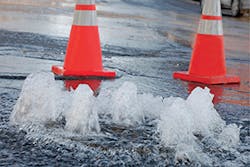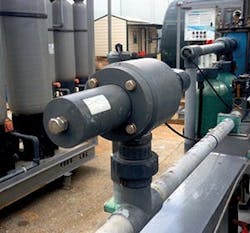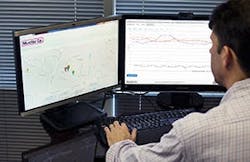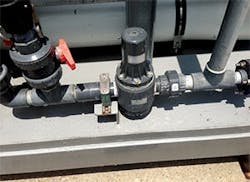Finding leaks and repairing them is a constant struggle for water utilities. Blame the aging pipes with which most utilities are working.
And surges in water pressure? They can add to the problem, putting extra strain on pipes. And if utilities are regularly pumping their water with too much pressure? Eventually, the extra force will damage pipes, causing more leaks.
In the most severe cases, pressure surges can result in costly water main breaks, breaks that can shut down entire streets and bring negative attention to water departments.
That’s why it’s so important for utilities to monitor the water pressure in their drinking water and wastewater systems. When utilities do this, they can quickly uncover pressure surges. They can find those areas of their distribution systems in which water pressure seems unnecessarily high.
By monitoring water pressure, utilities can even identify possible leaks before they grow into larger problems, saving utilities money over time.
The numbers tell the tale of how important pressure monitoring is. Sensus Systems, which makes water monitoring software, says that utilities lose $9.6 billion each year from water leaks. The company says that pressure management can help utilities reduce their leaks by 5%. That small improvement alone would save utilities up to $4.6 billion, according to Sensus.
NOT ENOUGH INFORMATION
The problem today is that not enough utilities have invested in pressure monitoring devices and technology. And without these devices, utilities can’t get an accurate picture of how strong the pressure is throughout their water systems.
Harold Mosley, product manager with the Cleveland office of Mueller Co., says that utility managers and operational personnel generally have a rough idea of their delivery systems’ water pressure at any specific time.
What they don’t know? What that water pressure is 24 hours a day, seven days a week.
That’s where water pressure monitoring—facilitated through devices like the pressure sensor developed by Mueller—comes in, says Mosley.
“What we have tried to give utility managers is a device that will allow them to capture pressure data on a regular basis, 24 hours a day, seven days a week,” says Mosley. “They will then have a blueprint or they can build a footprint of what is actually going on in their distribution system. They can monitor pressure wherever they want. It can be the most remote points in their systems or a point closer to the treatment plants. Wherever they have a theory that there are some pressure-related issues that need to be monitored, they can install our sensors to get an accurate picture of what is happening in their systems.”
Monitoring water pressure is key for utilities. Low water pressure can result in contamination from ground water. Severe ebbs and flows in pressure can weaken pipes, paving the way for future leaks. Sudden surges in water pressure can crack pipes and even cause breaks in a system’s water mains.
The long-term impact of pressure surges and ebbs is even more detrimental. Over time, these pressure surges can age water infrastructure too quickly, and result in leaks that spread throughout an entire water system, costing utilities dollars in the form of non-revenue water.
Proactive utility managers understand this. That’s why they don’t hesitate to invest the upfront dollars for pressure monitoring systems. They know that over time, tracking and reacting to pressure fluctuations will save them money.
When they are armed with pressure data, utility operators and managers can schedule maintenance before problems become more expensive. They can identify potential infrastructure failures before they happen. Operators can even use pressure monitoring to find large leaks in their systems, reducing the amount of non-revenue water they accumulate each year.
“Having a good knowledge of what the pressure looks like from 8 a.m. the morning to 8 a.m. the next day is an important tool for water utilities,” says Mosley. “You can really get your pressure readings refined down to the millisecond if you have an issue you are investigating.”
PRESSURE MONITORING IS A NECESSITY
Andy Ryan, technical sales manager for Cedar Grove, NJ-based Plast-O-Matic Valves, says all water and wastewater utilities should monitor and regulate the water pressure in their systems.
To not do it? That places the health of their pipes, pumps, and infrastructure at risk, Ryan says.
“Monitoring pressure is critical,” says Ryan. “You make sure your doctor measures your blood pressure. When you get your physical, they want to keep an eye on the pressure in your system to see if anything is going awry. They want to investigate any issues that might cause an increase or decrease in pressure.”
Ryan says that this works the same way with water pressure. If utilities don’t monitor pressure, they’ll be less likely to know when a potentially serious and costly problem has hit their systems.
A pressure regulator in a highly corrosive water treatment system. The PVC is impervious to the chemicals being used.
Mosley says that proactive water district officials, those who want to save money for their districts over time, are now using pressure monitoring to head off future problems.
Yes, they still rely on this technology to find current surges and dips in pressure, and then react to these fluctuations. But a growing number of water officials also know how important it is to understand why pressure fluctuations are happening. It’s important to find and quickly repair a line break. But it’s equally important to understand what caused that line break to happen. Monitoring pressure levels on a constant basis is one tool that water district officials can rely on to solve such puzzles.
“If you don’t know why a break happens, you can have multiple occurrences of the same problem in the future,” says Mosley. “Repairing a leak isn’t really solving the problem. With the right information, though, you can make adjustments. You might adjust your pump activity, for instance, to put less pressure on your system. You can change the way that you are operating your pumps to make sure that your pressure levels are more consistent, and this will reduce your future line breaks and leaks.”
Other utility managers turn to pressure monitoring to confirm their own suspicions that their water systems are already experiencing surges and dips in pressure. They already suspect irregularities and turn to pressure monitoring to verify their theories.
“Even in cases where their water pressure is regular most of the time, they are searching for verification that there are times when water pressures are more volatile,” says Mosley. “This is an especially important tool for engineers who are working on hydraulic modeling. These engineers want their hydraulic models to be as accurate as possible. But if they don’t have the dynamic data they need to give them that accuracy, their model can be skewed. Engineers appreciate this technology. It makes their hydraulic models more dynamic.”
EASY TO USE
Water pressure sensors are fairly simple to install and use. Water utilities typically install one sensor for every District Metering Area in a distribution system. The sensors then report pressure values at specific times set by the water utility through cellular service and an online server. This type of remote monitoring gives utility personnel the chance to keep a constant watch on their systems’ water pressure.
Mosley says that Mueller doesn’t promote its pressure monitors as leak finders. However, the company’s pressure monitors do help utility officials identify areas in their systems where there are pressure irregularities. These irregularities can lead to future problems that can cause leaks to spring up throughout their systems.
Other customers have uncovered significant water main breaks more quickly thanks to their pressure monitors, Mosley says. He cites one municipality that received an alert that pressure dropped in a portion of their system to an incredibly low 5 psi. Crews hurried to the site to find a 16-inch water main break. Without that early alert, who knows how long it would have taken to discover and repair that break.
“Within minutes of getting that low-pressure notification from the unit, the crews were able to discover the problem, and take action,” says Mosley. “Within 15 to 20 minutes of the pressure dropping, they were able to get to the site and start that repair work. Who knows how much damage they were able to prevent by reacting so quickly?”
For Mosley, the main benefit of pressure monitoring is information. By collecting pressure information and analyzing it, utilities can learn more about their water system.
“They get a better feel for what is going on in their systems,” says Mosley. “Being able to log that data and map it, if something does go wrong, you can refer back to something in the past. You can help narrow down what the issue is, where you need to go back and fix things. Maybe the water treatment plants in your system have changed their pump activity, so they are seeing higher pressures in areas where they hadn’t seen that before. You can now monitor that.”
As an example, Mosley points to a utility that for a four-hour period, monitored big swings in the water pressure throughout portions of its distribution system. The pressure was swinging from normal 45 psi readings to 250 psi bursts.
What caused this period of intense swings? Water district officials analyzed the data to find an answer. At the time of the pressure swings, the utility had also lost power to one of its pump stations. When the pressure from that pump station plunged, a backup generator kicked in and threw the pressure level back up. That created enough of a surge to send a water hammer in the line that went back and forth for about four hours, Mosley says.
The district officials, using data collected by their pressure monitors, were able to identify a cause for the unusual pressure surges, and then investigate their system to make sure that the surges wouldn’t happen again and did not cause any damage to the system’s infrastructure.
“Pressure monitoring does notify you when something is going on in your system,” says Mosley. “If something does happen, it can happen so fast. With the monitors, utility operators are notified within minutes of an occurrence. They can then quickly adjust to what is going on. If not for this technology, you might not know what is going on until something breaks.”
MAKING MONITORING A PRIORITY
Ryan doesn’t disagree, and says that pressure monitoring should be a priority for utilities that treat wastewater and deliver drinking water. Anything that tells utilities more about how their systems are operating needs to be embraced, Ryan says.
“Monitoring pressure is always critical,” says Ryan. “How can you tell if there is a problem if you can’t monitor the pressure in your systems?”
Plast-O-Matic manufactures sturdy pressure regulators, valves that utilities can use to reduce and regulate either steady or varying inlet pressures. By using these valves, utilities can maintain a constant, predetermined pressure throughout their wastewater or drinking water systems.
Plast-O-Matic’s valves come in a variety of types—including spring-, air-, and differential-controlled—and a range of sizes.
Near-time data can be used to enhance
hydraulic models and decision-making
Ryan says that there are too many dangerous problems that can occur throughout a system to give water managers the luxury of skipping out on pressuring monitoring. He points to the phenomenon of water hammer. This is a dangerous pressure surge that occurs when water that is moving through a distribution system suddenly stops or changes direction.
The intensity of a water hammer pressure surge can cause serious problems, everything from leaks to entire pipe collapses.
“There are things that occur in a water system that are dangerous,” says Ryan. “Utilities have to control their water system’s volume and velocity if they want to prevent something like water hammer. Water hammer is serious. It could cause a system’s joints to fail. One of the prime considerations, and what pressure monitoring helps utilities do, is to make sure that you have control of your velocity and pressure.”
Ryan says that utilities that monitor water pressure can learn valuable information about their water distribution systems, and uncover evidence that certain portions of their system might be facing leakage problems soon.
For instance, what if utility managers discover that their systems are seeing an increase in water pressure but at the same time a drop in the flow rate of their water? That could be a sign that filters throughout the distribution system are starting to fail.
Manuel Parra Batres, general manager for Smart Water Software at Schneider Electric, says that utilities that monitor their system’s pressure—and use high-tech remote-monitoring solutions to do so—can greatly reduce the number of leaks that their systems experience. Utilities can also find leaks faster, giving them the opportunity to make repairs before they grow into even larger and costlier problems.
This is important. Water officials estimate that about 20% of the water treated and distributed by utilities is lost every year. Some of this non-revenue water is the result of damaged meters that don’t accurately register the gallons of water that utilities deliver. Other non-revenue water comes when customers purposely damage meters.
But most of the non-revenue water that utilities suffer comes from pipe leaks. Anything that can prevent these leaks is crucial, Parra Batres says.
This is especially true when considering just how damaged the country’s water infrastructure already is. A much-cited 2008 study by the US Environmental Protection Agency reported that water utilities would need to invest about $400 billion over the following two decades to rejuvenate the country’s aging water distribution systems.
Of course, that investment hasn’t happened yet, so the cost of repairing water infrastructure has certainly risen since that study was released.
Parra Batres says that remote monitoring systems, such as the Smart Water suite of services offered by Schneider Electric, can perform predictive analysis to help utility officials predict where leaks might spring. Schneider’s software analyzes the pressure pumping through a water distribution system. It can then determine if the pressure rates are so high that they could cause a leak in the next 48 hours.
If the software determines this, it will send an alert to the utility. Utility managers can then take the steps necessary to reduce the pressure in that portion of their system.
“It’s about reacting to situations before they become problems,” says Parra Batres. “This is better than reacting to leaks after they start. You can protect your systems and resolve problems before your pipes develop a new leak. It’s a more efficient way to handle possible problems.”
A pressure regulator in a highly corrosive water treatment system. The PVC is impervious to the chemicals being used.
THE PAYBACK PERIOD
Utility officials are often struggling with tight budgets today. Manufacturers, then, must convince these officials that by investing in pressure monitoring systems, they’ll save enough money by identifying and heading off potential problems to enjoy a quick payback of their upfront costs.
“There is a return on investment,” says Mosley. “If you can prevent a problem, prevent a leak, and prevent damage to equipment, you are saving money.”
Say the water distribution pipes are rated to a level of 100 psi. If the system is routinely pushing water through the system’s pipes at 150 psi, you will eventually wear out your infrastructure. And that will lead to future leaks, water main breaks, and damaged equipment.
This begs the question: If pressure monitoring is so important, and if it can save water utilities so much money each year, why aren’t more utilities investing in pressure monitors and remote pressure-monitoring systems?
Ryan says that too many utilities haven’t invested in the equipment they need to track and analyze the water pressure in their wastewater or drinking water systems.
“I wish I had a dollar for all the water managers who’ve told me their systems don’t have pressure gauges,” says Ryan.
Mosley says that pressure monitoring is still a relatively new technology. So some utilities are simply reluctant to test it out until they become more familiar with it.
Other utilities still have staffs of long-time veterans at their utilities. These staffers have long relied on their own experience to judge whether their water distribution systems are operating properly, Mosley says. They don’t want to rely on technology to tell them when their system is experiencing an anomaly.
“These guys have a tremendous amount of experience with their particular water system,” says Mosley. “They have a feel for what they believe to be accurate pressures in their systems.”
Mosley, though, says that more water utilities are ordering pressure-monitoring systems today. He credits an industry that is steadily becoming more comfortable with automated systems and the desire of more utilities to find and fix problems before they become more serious issues.
“Investing in some technology like this is becoming the wave of the future,” says Mosley. “Utilities understand the benefits that pressure monitoring brings. As understanding increases, you will see a greater charge toward investing in technology like this.”
Water utility officials do have to protect their pressure gauges. The water industry typically relies on metallic gauges. These gauges, though, might face wear-and-tear from the chemicals that utilities often must use while treating water. Exposure to these chemicals for too long can lead to corrosion of the metallic gauges.
Plast-O-Matic, though, offers its own solution to protect these pressure gauges. The company manufactures gauge guards, also known as instrument isolators or diaphragm seals. These devices made of vinyl offer an extra layer of protection for sensitive gauges. The harsh chemicals can’t get through the Plast-O-Matic gauge guard, and then can’t corrode or otherwise damage the measuring device.
“What we do is offer a security blanket to someone who is looking to measure pressure,” says Ryan. “Our gauge guards are diaphragm seals that isolate a pressure-sensing gauge from contact with other media.”
Without such protection, utility officials are putting their monitors at risk, Ryan says.
“For us, a gauge guard is a simple device, but a critical one, too,” says Ryan. “If a gauge is on the line but you don’t protect it and it becomes corroded, what good is it?”



